#the gulf muhly grass
Text

gulf coast muhly going pink and gold
7 notes
·
View notes
Photo
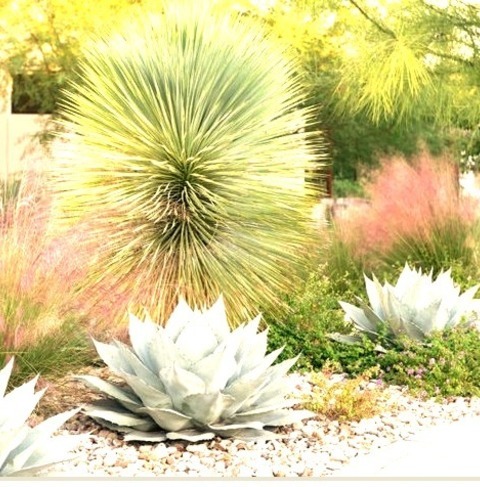
Landscape River Rock in Austin
Design ideas for a large contemporary drought-tolerant and full sun front yard river rock garden path in fall.
0 notes
Text


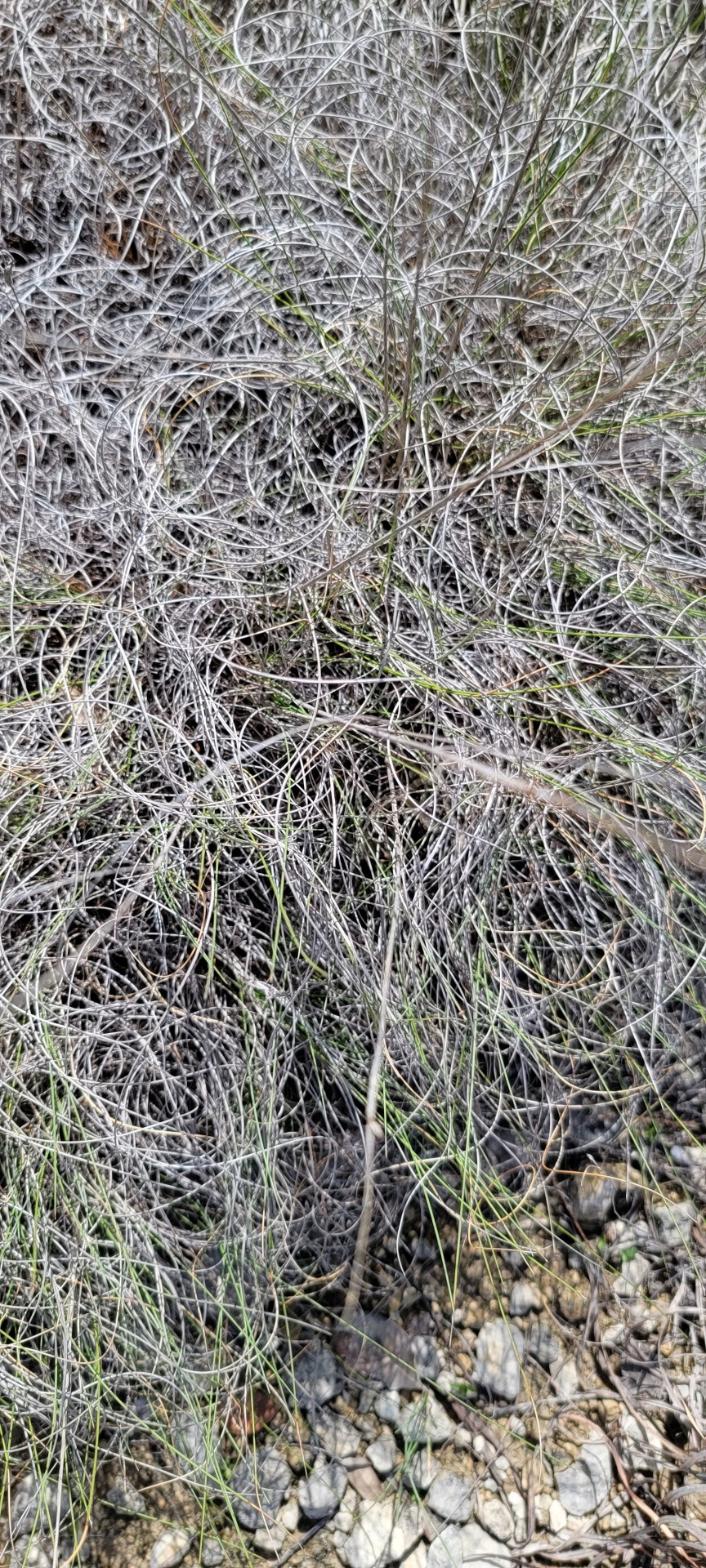
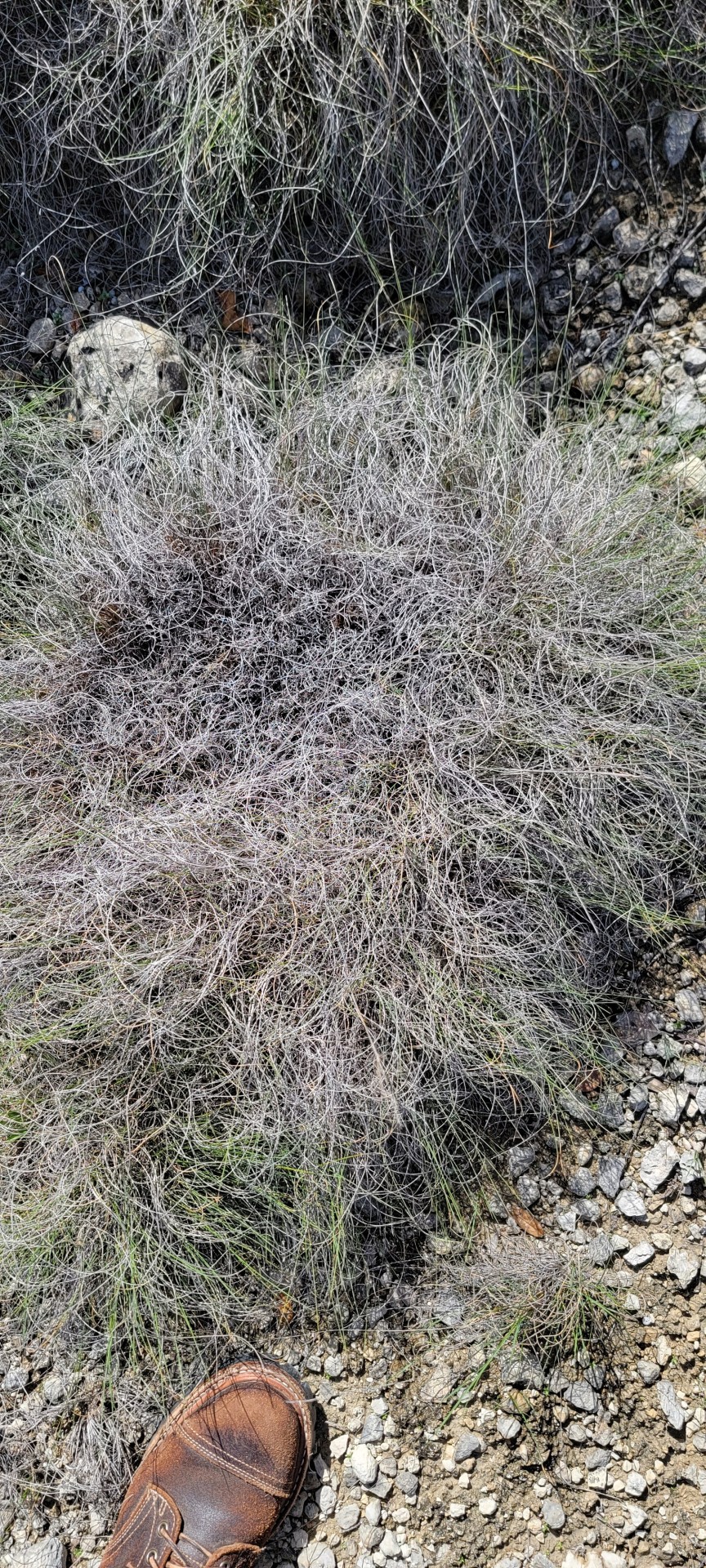
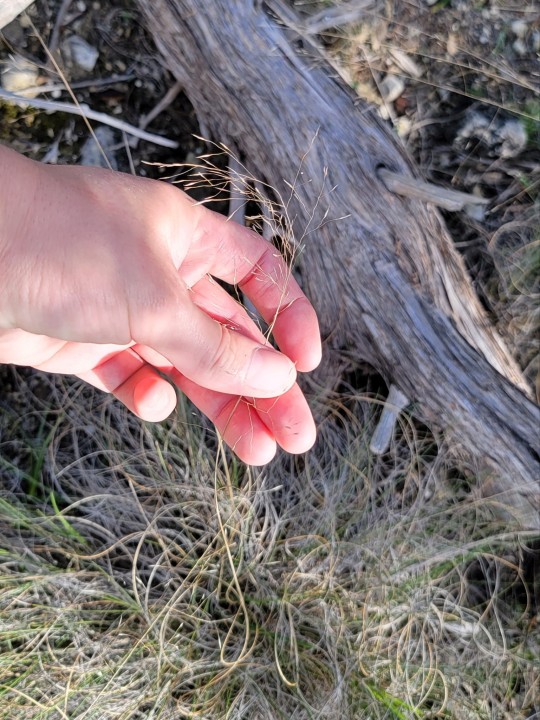
Seep muhly (Muhlenbergia reverchonii). Like its larger and more widely cultivated relative Gulf muhly, this is a bunchgrass, meaning they form discrete clumps rather than spreading out via rhizomes or stolons like a sod grass. These are just breaking domancy, allowing a clear view of the wiry, curly, dead blades retained at the base, forming dense mounds. These help trap seeds that might otherwise continue to wash or blow downhill. While the clumps themselves are too tightly packed for anything to grow through, you will often find other plants on their immediate perimeter.
19 notes
·
View notes
Text
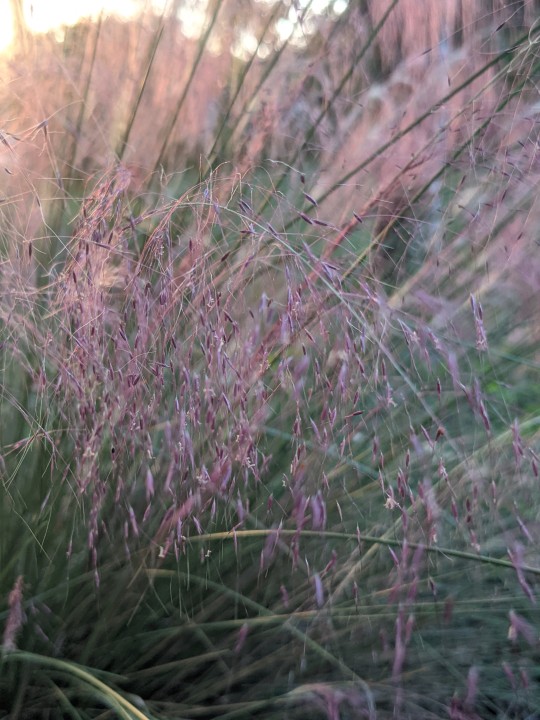
Muhlenbergia capillaris (gulf muhly)
lovely autumn bloom of a native grass
pinellas county, waning gibbous, cardinal autumn
1 note
·
View note
Link
“I would like to say that I was rooted, once, at least. Everyone grows up somewhere. The place where I grew up is not the place I was born. It is not the place where my mother and ancestors are buried. It is not the place where I live now. Still, I find that I know that place like I will never know any other. My body remembers that place, the skies, the light, the storms, the smells. My body remembers the bird songs and cries, the trees and plants, the snakes and fish, the roar of surf crashing on coral sand.
Mockingbird, mourning dove, pileated woodpecker. Fire ant, paper wasp, green anole. Coontie, hawk moth, blue porterweed. Slash pine, saw palmetto, diamondback rattler. Pink muhly grass, purple lovegrass, shiny blueberry. Passionflower, sandspur, black-eyed Susan. Scrub jay, coral snake, gopher tortoise. Buttonwood, cocoplum, red and black mangrove. Great blue heron, osprey, roseate spoonbill. Cormorant, anhinga, white ibis. Alligator, mullet, snook. Coconut palm, royal palm, gumbo-limbo. Turkey vulture, bald eagle, swallow-tailed kite. Key lime, strangler fig, cabbage palmetto. Sea grape, sea oats, bay bean. Least tern, common tern, black skimmer. Lightning whelk, lettered olive, coffee bean trivia. Manatee, manta ray, bottlenose dolphin. Stone crab, tarpon, brown pelican. Sailfish, flying fish, hammerhead shark. Dolphinfish, wahoo, great barracuda. Thunderhead, tropical storm, hurricane. For no other place on earth could I invoke a litany like this. All these names are also, for me, place names. Each one calls back exact memories, real experiences in specific landscapes, in familiar yards or lots, pine savannahs or saw grass wetlands, on stretches of shore known intimately to my feet, or out at the edges of the Gulf Stream, on swells felt and remembered by my inner ears. Every name, and the life it names, places me in a region of memory where body and place are more real and vivid than my sense of passing time. These memories, these imprints, and the stories that circle them are, I find, incredibly important to me. They continue to connect me. I cannot imagine them ceasing to connect me. Memories are said to be fluid and evasive, slippery and shifty. And yet these feel durable, outside of time and change and the necessity of death. They are my memories. When I die, they will die, surely, as memories. But they will live, surely, as the echoing life of those places. This “surely” is not modern. I am unrooted, but I carry, I find, a deep, more-than-rational refusal of modernity. These names, memories, experiences are more than mine. They have their own force of life, call it energy, or spirit. So, the land, the air, the waters are, I find, alive as some have always said. They seethe and vibrate with life and energy and emotion. Through that place, where I am from, I retain something, some hint or hit or touch of its pulse, of a life that is more than me and more than any human.”
#indigenous#thought#modernity#as#ecocide#and#genocide#Gene Ray#Linda Hogan#Robin Wall Kimmerer#many more
2 notes
·
View notes
Photo
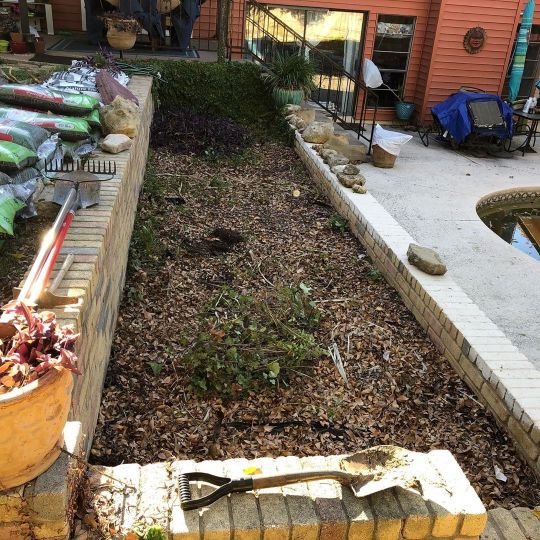
Stripping planting areas of landscaping fabric is just as important as ridding areas of non native invasive species. This weekend we did both. And replaced with native grasses (Big Muhly & Gulf Muhly). Once grown in (usually one season), this will be an area with purplish pink and golden hues. Native grasses are wonderful for pollinators, as many grass skippers use them as host plants. And birds use the leaves too for nest building. #NativesForWildlife #NativesAreImportant #PocketPrairie #NativePocketPrairie #NativeGrasslands #EcoregionsMatter #TheNectarBar #PlantNative #PeaceLoveAndButterflies #Butterflies #NativePlants #Nature https://www.instagram.com/p/B6G2FEenXqp/?igshid=1xlq0tnn4n315
#nativesforwildlife#nativesareimportant#pocketprairie#nativepocketprairie#nativegrasslands#ecoregionsmatter#thenectarbar#plantnative#peaceloveandbutterflies#butterflies#nativeplants#nature
0 notes
Link
For just $4.49 Purple Muhly Grass,Also known as Gulf Muhly Grass or Hairawn Muhly Grass,grows in drought conditions as well as wet conditions Purple Muhly Grass (Muhlenbergia capillaris) - Grow Purple Muhly Grass from ornamental grass seeds, and enjoy one of the most widely used and admired ornamental grasses. Also known as Gulf Muhly Grass or Hairawn Muhly Grass, this grass grows in various areas across the United States although it is native to Texas. The blue-green foliage is needle-like and gives the plant a stiff upright growth habit. Muhlygrass offers a beautiful display in the fall with a delicate, purple cloud-like affect. Muhly ornamental grass grows in drought conditions as well as wet conditions, and it prefers full sun although it will tolerate partial shade. Purple Muhly Grass grows best in fertile soils, and if your soil is poor, consider adding organic matter to improve the condition of the soil. TIP Try growing them in beds with deep pink shrub roses, or place them in front of other grasses like pampas, purple fountain or black bamboo. Group three together for an especially showy display How To Grow Purple Muhly Grass From Ornamental Grass Seeds: In the spring, once temperatures are warm and frost danger has passed, prepare a seedbed by loosening the top 6 inches and raking to a fine tilth. Remove rocks and clumps and smooth the soil flat and even. Place Purple Muhly Grass seeds on the seedbed and press them firmly into the soil. Keep the ornamental grass seeds moist until germination occurs. Ornamental grass care includes cutting the plant back within twelve inches from the ground during the winter months before new growth in spring. After pruning, add a small amount of fertilizer to the soil around the ornamental grass. Grass Specifications Season: Perennial USDA Zones: 5 - 10 Height: 36 - 48 inches Width: 24 - 36 inches Foliage Color: Blue/green Flower Color: Purple Fall Color: Purple Soil Requirement: Fertile, organic soil, dry or moist, ...
0 notes
Text
Beneficial Classic & Contemporary Design: Garden Conservancy Austin 2019
So, what does “drought tolerant” really mean?
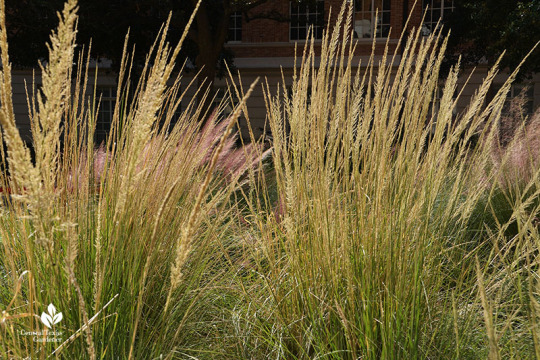
Daphne tells us: “Plants that are ‘drought tolerant’ are able to withstand prolonged periods without rainfall or supplemental irrigation. But to do so, they may go into dormancy, similar to how they do in winter.” Trees drop leaves prematurely, or they brown or color up early, as they’re doing right now.
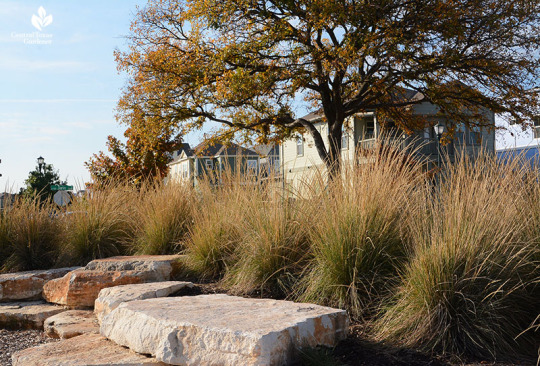
Get her complete answer and when to move citrus plants.
Native Lindheimer muhly, an ornamental clumping grass, was recently awarded Texas Superstar status for its performance across the state on a wide spectrum of climates and soils.

This deer-resistant grass—acclaimed for its showy foliage and fall blooms—is considered “drought tolerant,” according to Dr. Brent Pemberton of Texas A&M AgriLife Research, but requires irrigation when temperatures are elevated and rainfall is scarce.

At the same time, it’s a rain garden plant that helps stormwater infiltrate the soil, as does pink-hued Gulf muhly and low growing sedges. Find out more!

Looking for ideas with drought-tolerant, deer-resistant plants or stormwater control, rainwater collection, and outdoor living?

John Hart Asher from the Lady Bird Johnson Wildflower Center joins Designer Casey Boyter and Patrick MacRae from The Garden Conservancy to preview Austin’s Open Days November 2 tour that gathers designs from classic to contemporary.

Watch their tour preview now!
On tour with the “Berger Street” Open Days garden: Tucked into east Austin, Rita Little-Byrd and Keith Byrd’s diminutive house built in 1925 hasn’t changed its footprint; it just upped its romance and habitat highway.
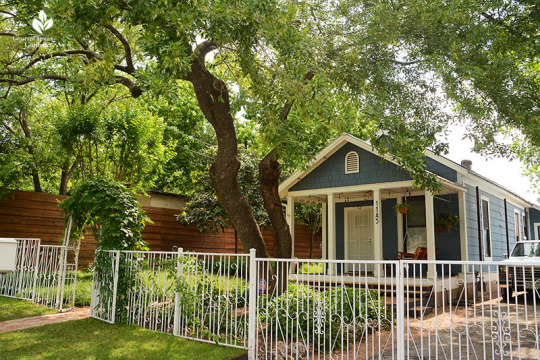
Over 10 years, Keith worked on both home and garden, and built the cedar and metal post fence.

He remodeled a 1952 Royal Spartanette and shipping container in back for office and storage space.
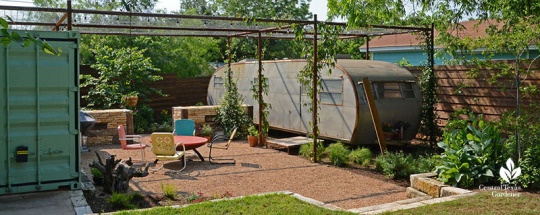
When he and Rita decided to hold their wedding at home, Keith called on long-time friend Billy Spencer of Spencer Landscape Company to add the “icing on the cake.”

Shademaker Studio landscape architect Shaney Clemmons pulled together their ideas for welcoming outdoor living with contemporary flair and easy-care plants for wildlife.

Since an active, gregarious dog lives here, too, there’s lots of running room in back on zoysia grass and fence line patrol zones. All plants are non-toxic.
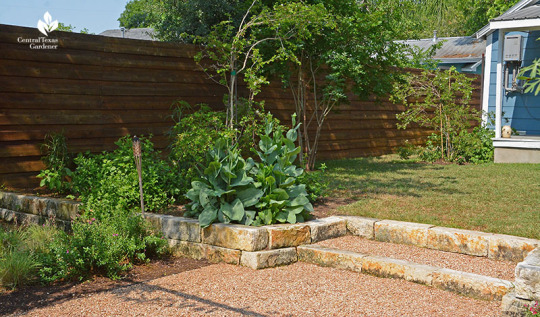
In the no-lawn front, Billy brought an elderly American ash to health for now, already underplanted with shade-loving crinum lilies, turk’s cap, and liriope.

Keith had spruced up the charming old fence. Billy moved a resident climbing rose to the brighter spot to greet the neighbors with flowers once again.

Keith framed the old, romantic arbor with a grapevine.
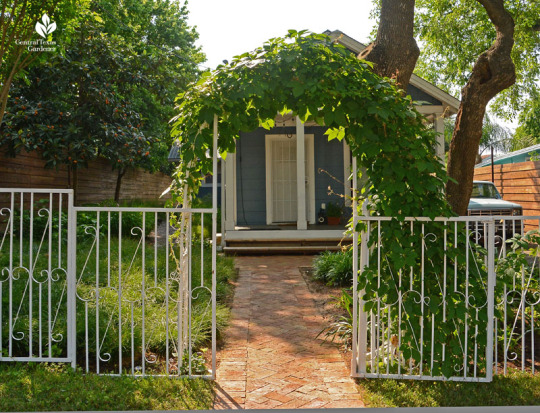
Shaney patterned Mexican adobe brick pathways for a low-glare, warm welcome and mud-free traffic from driveway to house and to the side yard.
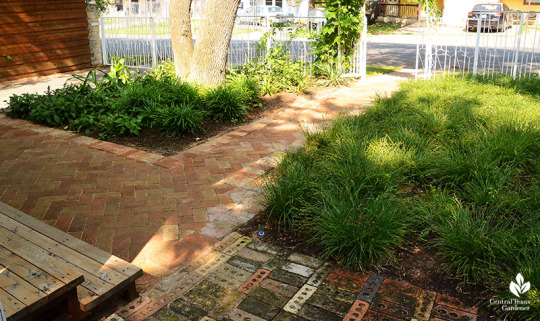

The biggest change was Shaney’s front porch design with wide steps, perfect for sitting and chatting with this friendly neighborhood.

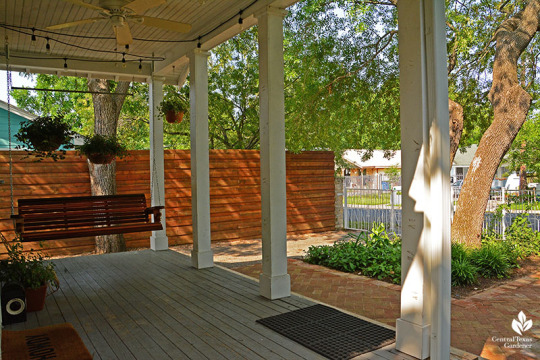
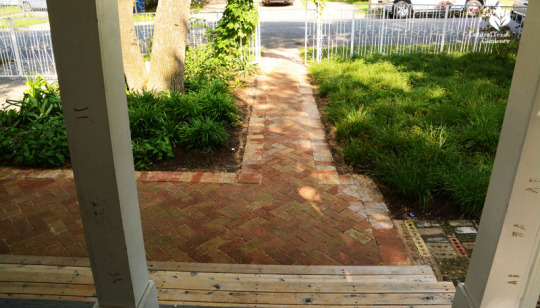
For a soothing, uncluttered entrance, they massed soft Berkeley sedge with Turk’s caps and other dappled-shade lovers.

In the narrow side yard, Keith’s stockpile of reclaimed bricks now wend a path against clusters of bamboo muhly and inland seaoats. Clustering plants makes a small space seem larger, more cohesive, and easier on maintenance.

The existing loquat tree invites wildlife with fall flowers and spring fruit. Rita and Keith gladly share the bounty with squirrels, birds, and butterflies.
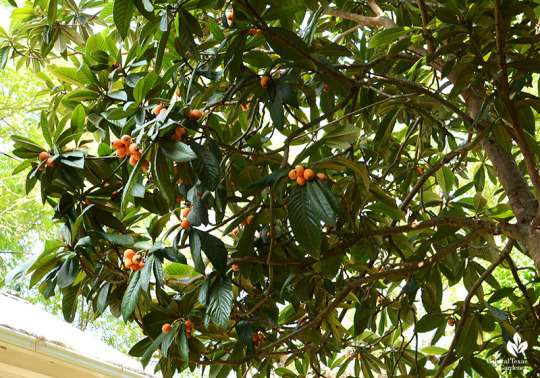
A bevy of butterflies sailed around us, feeding on brick-warmed fallen fruits, including Question Mark and Red Admiral.
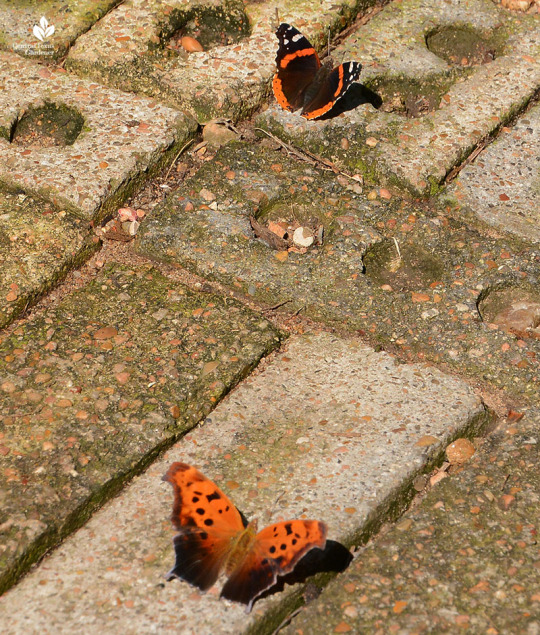
This Question Mark took a quick break.
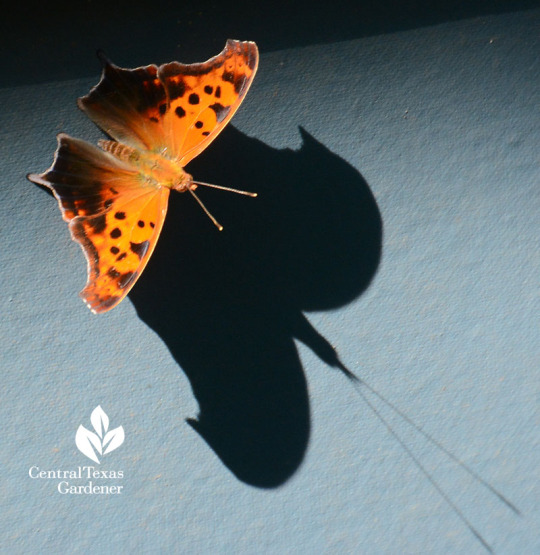
The sunnier backyard supports Rita and Keith’s flowering native and adapted plants for wildlife. Spring-blooming anacacho orchid (Bauhinia lunarioides) frames the back porch.

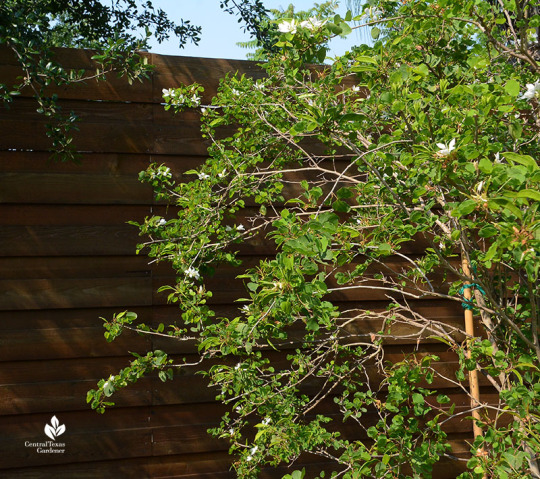
Since the house is tiny, Keith extended their living room outside. He installed and renovated the Royal Spartanette and shipping container for office and storage space. Billy and Shaney polished it up with a limestone-edged frame and pea gravel floor that anchors the table/fire pit and chairs without any sinking.

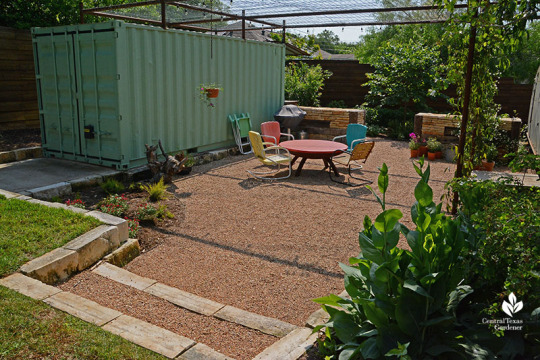
Keith had already built the rock walls to gently frame the patio room.
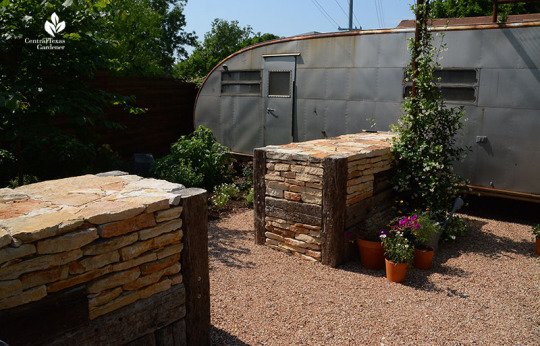
He left room behind for a grilling or gardening work space, out of sight behind the shipping container. A planted a narrow leafy wall of progressively flowering shrubs and perennials to shield the fence.
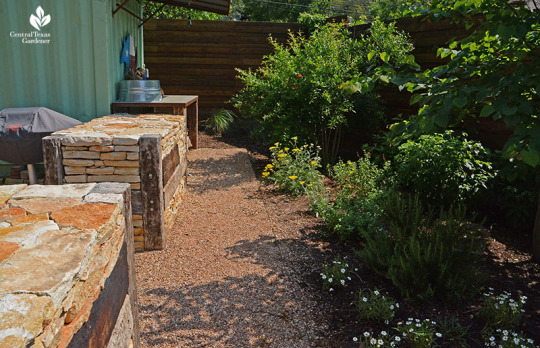
Billy and Shaney designed a light-filled ceiling anchored rolled netting to posts of reclaimed oil pipe. Young evergreen star jasmine and Clematis armandii will shade the patio in a few years, scenting late spring with white flowers.
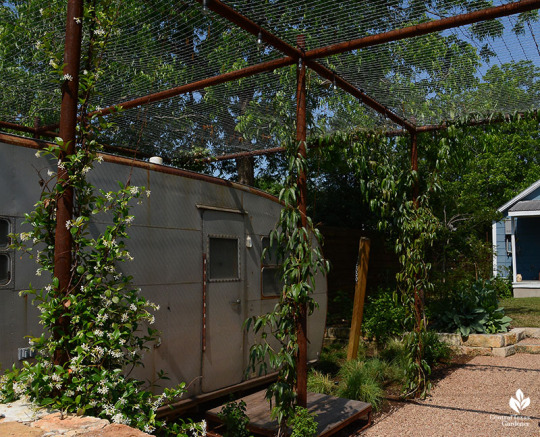
Rita and Keith’s wedding is October 19, 2019 (and looks like perfect weather!). But for them, every day’s a celebration with a daily guest list of wildlife.
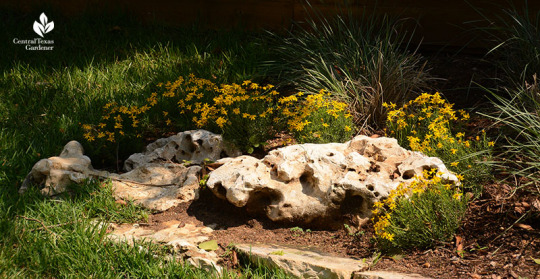
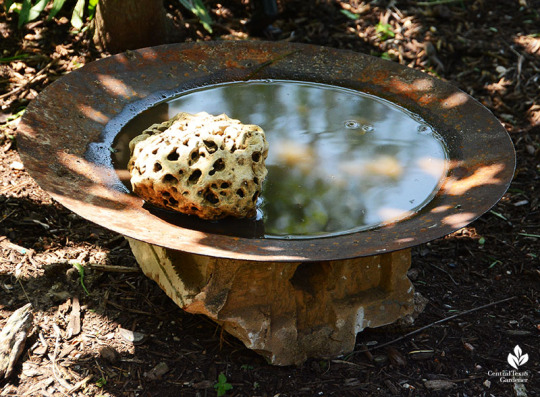

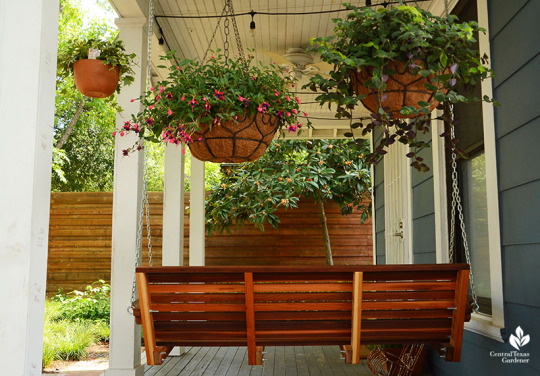
Watch their story now!
youtube
And thanks for stopping by! See you next week, Linda
Beneficial Classic & Contemporary Design: Garden Conservancy Austin 2019 syndicated from https://yeuhoavn.wordpress.com/
0 notes
Text
Autumn stroll around my garden
Autumn is my favorite season in the garden, when the Death Star abates and cool breezes blow in from the north, pushing that Gulf Coast humidity back to Houston where it belongs. The sky goes china blue, fall perennials burst into bloom, and fall-blooming grasses incandesce in the slanting sunlight.
I’ve been doing a lot of tidying and fluffing in my garden over the past few weeks because I had two photographers visiting plus a Garden Spark talk with 30 attendees who were invited to explore. And now I invite you to take a virtual stroll around the garden with me too.
But first, a salute for our tired old roof, which just got reshingled this week. It’s always a little stressful to have a roof torn off when you’re a gardener, but they were careful of the plants and I’m thrilled to have new shingles in an updated gray color.
In the island bed, ‘Vertigo’ pennisetum has grown to tall-dark-and-handsome proportions. The first freeze will turn it to brown straw, so I’m enjoying it while it lasts.
Here’s the view from our front door, with dwarf palmetto (Sabal minor), foxtail fern, pale pavonia, and ‘Sparkler’ sedge, my shade garden, deer-resistant faves.
Looking toward the house, with white skullcap, ‘Burgundy Ice’ dyckia, variegated flax lily, bamboo muhly, and ‘Scott’s Turf’ sedge.
Entry garden, hot and dry on the left and mostly shady on the right.
I redid the right-side foundation bed a couple of months ago, adding and rearranging dwarf Texas palmettos, spreading plum yew, ‘Everillo’ sedge, and a potted ‘Pineapple Express’ mangave. The wire “ball weeds” adding height to the mangave pot are from redgrassdesigns on Etsy.
The dry side is a gravel garden with ‘Vanzie’ whale’s tongue agave, toothless sotol, red yucca, ‘Frazzle Dazzle’ dyckia, and dwarf myrtle, plus ‘Alphonse Karr’ bamboo.
Now let’s stroll toward the terraced bed by the garage, where ‘Green Goblet’ agave holds court with woolly stemodia and mullein (a volunteer mullein is blooming in the decomposed-granite path by the garage), with another ‘Vertigo’ grass glowing burgundy in the background. A trio of ceramic balls adds a little color.
Looking lengthwise across the front garden you see the Berkeley sedge lawnette and potted foxtail ferns on cantera stone columns. In the long view you can see ‘Pink Flamingos’ muhly blooms glowing pink.
A TerraTrellis tuteur echoes the color of the ceramic spheres and adds height to the sedge garden. I’m trying a dioon here too, a plant I’ve been wanting to grow for a while now.
Standing at the corner of my neighbor’s driveway, we get to enjoy a view of her whale’s tongue agave and autumn sage in full bloom, with my garden in the background.
Prior to the photographer visits, I didn’t want to put up deer caging around plants that the bucks like to antler. But the wide-leaf giant hesperaloe at the front corner of the garden is particularly vulnerable, so I improvised with these low-profile, bent pieces of cattle-panel wire. It worked, although I did see evidence of a little antler-rubbing damage this week, so I quickly put up deer caging around this plant, the ‘Green Goblet’ agave, and a small possumhaw holly.
The side-garden path, with a ‘Blue Ice’ Arizona cypress visible beyond the gate. The path is lined with simple masses of pale pavonia, bamboo muhly, and inland sea oats.
A little stopping place along the path, with Mediterranean fan palm and blue mistflower attracting butterflies.
Self portrait in silver balls
In the back garden I have more leeway to play with plants that the deer would like to eat. Succulents are shown off in the cinderblock wall planter and in a narrow bed alongside the gravel path.
A closer view (here’s how I made it), with ‘Espresso’ mangave and squid agave in the foreground.
The upper patio was looking inviting prior to the roofing work, when I had to move everything away from the house. Oh well, it gives me a chance to powerwash the patio, which I’ve been meaning to do.
I enjoy my tentacled wall decor.
A closer look. In the green Crescent pot is a ‘Platinum Beauty’ lomandra I’m trialing from Southern Living Plant Collection.
I’m also trialing their ‘Marvel’ mahonia.
My new whale’s tongue agave, replacing Moby, who bloomed and died, is surrounded by silver ponyfoot.
Steps make a natural display space for potted plants (and are soon to be powerwashed!). Purple oxalis in a turquoise pot gets all the attention, of course.
Strolling past the pool and the raised bed behind the house, which is accented with a couple of blue pots
One contains a toothy, long-tongued Audrey monster.
The stock-tank pond garden is one of my favorite spaces.
The ‘Winter Gem’ boxwood spheres are recently clipped. I try to keep them all at the same height, even though one side of the garden slopes lower than the other, so as to create the illusion of level ground.
A slightly wider view shows the faux shed that my husband built to hide the pool pump equipment.
Bamboo muhly and ‘Color Guard’ yucca glow below the deck.
I recently replanted the lady’s head planter with succulent “ringlets.”
At the Alberta Street Fair in Portland this summer, I bought three metal dragonflies from Brian Comiso of Steelhead Metalworks. They ended up not fitting in my suitcase, so we borrowed a hacksaw and cut the stakes off, then had Bob of Gardening at Draco weld them back together when I got home.
Opposite the bamboo muhly and ‘Color Guard’ yuccas, a trio of squid agaves in culvert-pipe remnants stands amid white mistflower and forsythia sage.
Speaking of which, forsythia sage
Moving an umbrella stand revealed the hiding place of a striped garden snake, chilled in the morning air and not eager to move. So dapper in its striped suit!
It’s the time of year to admire the purple-black berries of Mexican beautyberry before the mockingbirds eat them all.
Another ‘Green Goblet’ agave, with dusty blue-green leaves, lolls in the lower garden beside a holey limestone boulder.
Strolling up the side path you pass a ‘Sapphire Skies’ Yucca rostrata, my oldest and biggest one. The ‘Blue Ice’ Arizona cypress behind it echoes the frosty color, as does a blue pot.
At the gate, butterfly vine tumbles over the fence, its chrome-yellow flowers in full bloom.
Looking back down the path
Lori of The Gardener of Good and Evil gave me this ferox agave as a large pup from one of her giants. I planted it in a sapphire pot with blue-gray Mexican beach pebbles as a topper. Eventually (soon?) it’ll start pupping, but I love it as a solitary specimen.
Yucca rostrata and the stock-tank pond
Climbing up on the deck you see the sunburst pattern of the patio stones around the pond.
The other direction
A wider view
This adorable metal bat was a birthday gift from my mom.
And our stroll ends with a long view across the pond garden, lower patio, and swimming pool. Swimming season is definitely over. Patio season is well underway.
I welcome your comments; please scroll to the end of this post to leave one. If you’re reading this in a subscription email, click here to visit Digging and find the comment box at the end of each post.
_______________________
Digging Deeper: News and Upcoming Events
Don’t miss the Austin Open Days garden tour sponsored by the Garden Conservancy on November 4.
Join the mailing list for Garden Spark Talks! Inspired by the idea of house concerts, I’m hosting a series of garden talks by inspiring designers and authors out of my home. Talks are limited-attendance events and generally sell out within just a few days, so join the Garden Spark email list for early notifications. Simply click this link and ask to be added.
The post Autumn stroll around my garden appeared first on Digging.
from DIGGING: cool gardens in a hot climate http://ift.tt/2xs0kwY
via IFTTT
0 notes
Photo
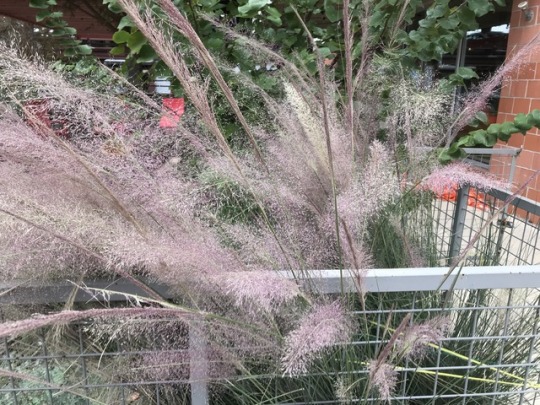
Muhly grass blooming at the office courtyard ( Muhlenbergia X 'Pink Flamingo' ) A cross between Gulf muhly and lindheimer, it gives a larger form but still the pink color blooms.
0 notes
Text
Linda Peterson’s green-walled xeriscape garden: San Antonio Open Days Tour
The highlight of the recent San Antonio Open Days garden tour, as I knew it would be, was Linda Peterson’s beautiful xeriscape and green-walled courtyard garden. Twice before I’ve had the pleasure of exploring Linda’s garden (in September 2015 and April 2016), and the artistry of her plant combinations, skillful pruning, and integration of garden art always delights.
Since I’ve written about Linda’s garden twice before (see links in top paragraph), I won’t do a play-by-play of her garden features. Let’s just stroll, shall we? First, the front garden outside the gray-green courtyard walls…
Agave weberi with purple-flowering cenizo. Lucky Linda for having her barometer plant — i.e., cenizo — burst into bloom for the tour! The timing of an ephemeral cenizo bloom cannot be planned since it responds to rainfall and/or air pressure changes.
A pair of octopus-armed steel agaves accent a corner planting of cenizo (pruned up like small trees), sprawling dalea, and ‘Blonde Ambition’ grama grass.
Linda has a knack for artfully pruning plants. She’ll prune up foliage to show off trunks or lift a plant’s “skirts” above the gravel mulch. Even shrubby rosemary gets neatened up with selective under-pruning.
A sinuous live oak’s snaky limb reaches out from a hole in the wall to embrace a stump seat and a wood-plank table.
It’s wonderful, and a one-of-a-kind feature that epitomizes Linda’s embrace of the Texas climate and its natural beauty.
A side view from the front walk, where a stepping-stone path leads around the tentacled live oak
Society garlic blooming alongside another steel agave
My friend Cat and I both exclaimed over this cute-as-a-button flowering plant, which looks like a compact gomphrena. I can’t remember the ID from Linda (maybe ‘Gnome’?), but I distinctly remember her telling me she found it at Lowe’s. Go figure!
“Beware: Sharp spiny plants with evil intent” — that dry humor is a dead giveaway that Linda made up this sign herself. And of course we gardeners know the real purpose of such a sign is to protect our precious plants, not the people who read it. Mind your feet, people!
Doesn’t look particularly evil, does it?
Heading around to the side yard
I always get a kick out of this grinning crocodile planter.
A Gulf fritillary butterfly enjoying purple lantana
Wavy-leaved prickly pear
Another big Weber agave
Tree limbs embrace overhead, as soap aloes hoist orange-flowered bloom spikes.
On the other side of the front yard, a side path widens into a small patio with a rustic bench. A green cloud of bamboo muhly grass hides the neighboring driveway from view.
“I’m nuts about you,” this stone squirrel could be saying to the Agave mediopicta ‘Alba’. (Groan)
Palms in culvert-pipe planters and a Weber agave
Looking back from the end of the path you get a marvelous view of the writhing arms of the Weber agave underplanted with writhing foxtail fern, backed by writhing live oaks. That’s a lot of writhing!
Step into the walled courtyard and you’re in Linda’s private outdoor living room. A pair of metal rhinos contemplates crossing the patio for a drink at the Mexican beach pebble “stream.” A winding river of soap aloes echoes the curving stone stream, and a variegated agave seems to wave encouragingly.
Metal armadillos root around in the garden bed.
The patio by the outdoor fireplace looks bigger and more inviting than ever. Linda has lightened up this year with fewer chairs and a see-through table.
An outdoor rug adds a bit of coziness and definition too.
A built-in bench along the wall holds an assortment of pumpkins, squash, succulents, and a candle lantern.
Even the metal barrel cactus were lit during the tour!
Such a relaxing space
Don’t you want to lounge here and take a nap under the live oaks?
A metal iguana guards a stand of ‘Vertigo’ pennisetum and a container fountain.
A couple of chairs plumped with pretty teal pillows with small mirrors sewn on for sparkle
I love Linda’s flowers made of bent copper tubing.
They show up so well against the minty green wall.
Heading around to the back garden, you stroll past a collection of potted plants and an elevated deck with cattle-panel privacy screening.
Cattle panel deck skirting is cloaked with fig ivy. No, it doesn’t stay this way on its own. Linda trims it to show off the grid pattern of the wire panel.
Understated pots in shades of brown are guarded by a metal horny toad — Texas’s state reptile, ya know.
A faux-bois fountain is a focal point at the end of the driveway.
An umbrella-shaded patio beckons where the path curves around the house.
A hanging wicker egg chair and bench offer additional seating.
Two metal giraffes nibble bamboo leaves nearby.
There’s not a patch of lawn in this low-water garden, but even so it feels lush and green.
Where there used to be a bottle shrub, Linda now has a hanging bottle tree, a less-common variation on the trunk- or pole-style bottle tree of the South. Linda uses lots of hanging objects — plants, lanterns, bottles — to draw the eye upward into the trees.
On a terrace off the back of the house, privacy is assured with a striking, contemporary privacy screen, which Linda designed out of leftover scraps of roofing metal (after their standing seam roof was installed) and she and her family riveted together. A bubbling fountain container topped with blue slag glass and a collection of containers completes the appealing scene.
Container detail
My thanks to Linda for sharing her remarkable garden again and letting us linger there so long!
And thank you, dear reader, for following along on my recap of the San Antonio Open Days Tour. I unfortunately ran out of time to see a couple of the tour gardens, but I enjoyed the ones we saw. For a look back at the old San Antonio style of the Tupper Beinhorn Garden, click here.
I welcome your comments; please scroll to the end of this post to leave one. If you’re reading this in a subscription email, click here to visit Digging and find the comment box at the end of each post.
_______________________
Digging Deeper: News and Upcoming Events
Don’t miss the Austin Open Days garden tour sponsored by the Garden Conservancy on November 4.
Join the mailing list for Garden Spark Talks! Inspired by the idea of house concerts, I’m hosting a series of garden talks by inspiring designers and authors out of my home. Talks are limited-attendance events and generally sell out within just a few days, so join the Garden Spark email list for early notifications. Simply click this link and ask to be added.
All material © 2006-2017 by Pam Penick for Digging. Unauthorized reproduction prohibited.
The post Linda Peterson’s green-walled xeriscape garden: San Antonio Open Days Tour appeared first on Digging.
from DIGGING: cool gardens in a hot climate http://ift.tt/2gCamEU
via IFTTT
0 notes
Text
Visit to Fort Worth Botanic Garden and Japanese Garden
Although I’ve been to Dallas and its well-known public garden many times, until last weekend I’d never visited the botanical garden in nearby Fort Worth, just 45 minutes to the west. While not showy like Dallas Arboretum, Fort Worth Botanic Garden is a pleasant place to stroll amid perennial gardens, arbors and gazebos (likely popular with wedding parties), and woodsy trails.
On this early October day, monarchs were passing through, fueling up for their journey to Mexico.
I’d never seen this type of big, golden bee before. When I posted a picture on Instagram, a reader identified as possibly a male valley carpenter bee. That’s esperanza (Tecoma stans) he’s enjoying.
Orange and pink hibiscus adds tropical color.
Fluffy, cotton-candy wisps of our native Gulf muhly grass (Muhlenbergia capillaris) were catching the light.
Another native plant, fall aster (Symphyotrichum oblongifolium), was a hit with honeybees.
This massive arbor, with a rough-cut tree trunk serving as the top rail, is a striking portal.
The real attraction of the garden, however, is the Fort Worth Japanese Garden, which has a separate parking area and an entry fee (the main garden is free). The entry tower, pictured here, makes an impressive gateway into the garden.
Roofed arbors beckon you further into the 7.5-acre garden.
The garden was constructed in 1973, and it has a somewhat dated feel, although it’s neatly kept.
Still, it’s a pleasant place to spend an hour or more in leisurely enjoyment of the outdoors, with some very nice Japanese-style structures and garden art.
I especially liked this somewhat contemporary pagoda sculpture.
Coming around a bend in the path, this was a fun surprise: a trio of see-no-evil, hear-no-evil, speak-no-evil monkeys on stone steps leading nowhere.
A large pond occupies the central part of the garden, with a winding path leading around it and offering scenic views like this arching moon bridge.
This small gazebo perches at the water’s edge amid a scrim of Japanese maples.
Lacy leaves of Japanese maples overhead.
Koi followed us around the pond like hungry pups waiting for a handout. The garden sells fish food, and many visitors were delighting in feeding the colorful fish.
Look at those open mouths!
Whoa! This big boy could practically swallow your arm.
Decks like this one offer up-close pond-viewing places.
Beautiful bark on what my friend Diana identified as an elm tree.
A pretty teahouse seems to float over the pond, framed by bald cypress and pine trees.
Heading around to the gazebo
Stone lantern
The very earliest Japanese maples were beginning to turn.
Such beautiful fall color — and unexpected. I thought we’d be too early for it.
I’ve always liked bamboo-and-basin fountains like this.
A “floating” path of stepping stones attracts adventurous and sure-footed explorers.
Another deck offering a scenic spot to enjoy the pond.
A flaming red and orange Japanese maple attracted my eye — so beautiful against a clear blue sky.
Climbing up the slope we found a large elevated deck and a cluster of roofed shelters that seemed meant for weddings or other events. With their sharply peaked roofs and cross designs, they almost seem Scandinavian, don’t they?
Back on the main path, I spotted palmettos along a stream with a small waterfall…
…and enjoyed a new view of the moon bridge.
More decks
A tricolored heron (as a fellow photographer ID’d it) was fishing for minnows swarming around a mess of fish food that had been tossed in the pond.
I stopped to watch him for about 15 minutes as he inched toward the water…
…stretched out his neck…
…and struck!
He was an effective fisherman.
A fellow fisherman got in his way a few times: a long water snake that coiled and flashed through the water in pursuit of minnows. I was amazed how many passersby were afraid when they saw it, sure it was a water moccasin that would leap out to get them. But no, it was nonvenomous and just wanted a fishy meal.
This lovely wooden pagoda near the exit stands about 20 feet tall.
A nicely designed gift shop beckons near the exit…
…its porch framing a view of a young ginkgo in golden fall glory.
I welcome your comments; please scroll to the end of this post to leave one. If you’re reading this in a subscription email, click here to visit Digging and find the comment box at the end of each post.
_______________________
Digging Deeper: News and Upcoming Events
Don’t miss the Austin Open Days garden tour sponsored by the Garden Conservancy on November 4.
Join the mailing list for Garden Spark Talks! Inspired by the idea of house concerts, I’m hosting a series of garden talks by inspiring designers and authors out of my home. Talks are limited-attendance events and generally sell out within just a few days, so join the Garden Spark email list for early notifications. Simply click this link and ask to be added.
All material © 2006-2017 by Pam Penick for Digging. Unauthorized reproduction prohibited.
The post Visit to Fort Worth Botanic Garden and Japanese Garden appeared first on Digging.
from DIGGING: cool gardens in a hot climate http://ift.tt/2xImfEz
via IFTTT
0 notes